New Zealand Tour 4: Reefton
After a tour of the North Island’s distilleries, I headed back south… then west …
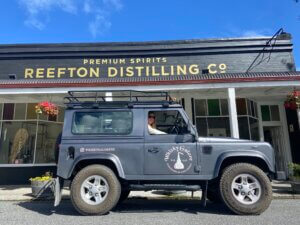
The flight from Auckland’s on time. Clouds over the coast, a glass of Syrah to ease the journey. In Christchurch, reunited with Siona from Whisky Galore, we head west. The early evening roads are quiet. We gamble on where to stop for food. Head to Hurunui and risk the kitchen being closed, or play safe? We choose the former. A pub’s bound to be open, isn’t it?
That thought begins to look overly optimistic as we drift through small towns locked up for the night. The feeling’s compounded when we spot the ‘For Sale’ sign outside Hurunui’s old hotel. Inside, there’s one table of silent diners and no sign of staff. It’s 8 o’clock, and last orders have been called, but they take pity on us.
Our B&B is a half mile or so further on. Ann & Matthew Newton’s Hurunui Homestead is a glowing wood-panelled dream of a home. We chat with them, discovering about garlic farming, going organic, and the dishonest users of honesty boxes.
‘Do you like porridge?’ Matthew asks the next morning. How could I refuse? A massive bowl of it appears, which I take in Scottish fashion (or as we say, the right way) with salt and a drop of milk. There is some consternation.
They’re preparing for a day of garlic sorting and carrot planting. ‘Hawkes Bay’s been hit by the cyclone, says Matthew. ‘I can corner the carrot market!’ We leave them in their 50 acre paradise. Two hard-working people getting on with things, unflappable, reacting to change.
Fully porridge-lined, we head north, then west. Sharp ridges like flicks of a calligrapher’s brush, mauve mountain slopes, sharply defined in the low morning sun. The sense of the seethe under the rocky skin. Manuka and black beech, glades and passes, as the road finds its way over braided rivers and moraine.
The chat’s of the need for balance between native old growth vs plantation. There’s tax breaks being given for planting conifers, giving greenwashing companies a chance to dubiously claim about carbon offsetting. Then there’s the issue how to balance reforesting with the need for grazing land. Finding some degree of parity between farming and sustainability is not easy – but has to happen.
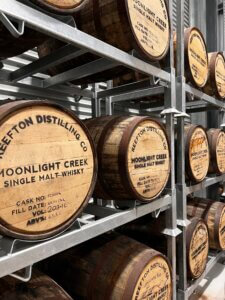
We’re following the trails first laid through the mountains by the Kai Tahu people and pounamu (greenstone) miners, then the 1860s prospectors hunting for gold, then coal. The west coast is a place of delvers and diggers, of dreamers and get-rich-quick salesmen. Its fortunes have flared and waned as seams have been hit then exhausted. Fortunes and population surge and recede like tides. The call of the west has come in multiple voices.
The road climbs, the trees ever higher. Then a break in the forest, downhill, and we’re in Reefton, its main street with low wooden buildings and covered walkways, tin roofs and alarmingly tall lamp posts (this was the first town in the southern hemisphere to have electric street lighting). It’s like walking onto the set of a western. You wouldn’t be surprised to see a hitching post.
Here was the reef on which those tides broke. Boom times brought first by gold, then came coal, and forestry. In 1899 this wee town had 16 hotels and two banks.Then the gold went, now coal is in decline, and forestry ain’t what it used to be. The population of the west coast is falling as prospects dwindle. How to reverse this trend? One solution lies just off the main drag.
This is the HQ of the Reefton Distilling Co., home to Little Biddy gin, named after a four-foot tall, pipe-smoking, gin-swilling 19th century prospector. It was the brainchild of Reefton-born Patsy Bass, who’s arranged to meet us at the Broadway Tearooms. She arrives, mildly flustered, apologising for being late (though she’s not), due to being held up by the builders at her latest project – converting one of the old banks into a house. As we walk along the sidewalk, she says hello to everyone. It’s one of those places.
The idea behind Reefton Distilling Co. wasn’t the result of a campfire chat, or seeing a gap in the market, but as a way in which to revive a town. ‘Every shop had closed down,’ Patsy explains. ‘It was just junk shops. There was no place for visitors to spend money or have a reason to stay. I didn’t want this place to die, so the solution was to create business with jobs that weren’t reliant on the extraction industries.
‘Whisky was the initial idea, but we have local botanicals, and making gin allowed us to have cashflow.’ A share equity offer raised NZ$1.3m, and Little Biddy appeared in 2018. The range is now eight strong and has been joined by Wild Rain vodka.
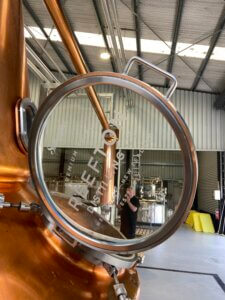
‘All the young people aspired to was getting out of Reefton,’ she adds. ‘Having the gin meant there were jobs. Now we have 25 staff distilling, bottling, and running the shop and giving tours. We want to make the west coast sexy.’
It was a catalyst for change. ‘People could begin to see what was possible here, that we could bring life back.’ New businesses meant people moving to the town, old premises and houses were painted. Rathercthan passing through, tourists stopped, went to the cafes, shopped in the (excellent) art gallery, then stayed overnight.
In 2022, after a second fund raising campaign raised a further NZ $3.3m, a 1.6ha site on the outskirts of town opposite the old station was bought. The new distillery is housed here, in a large hanger which dwarfs the pair of angular Tasmanian-built stills. There’s plenty of space for expansion.
‘Last time I saw you was at Glenkinchie,’ says the chap walking towards me. Distiller (or ‘distillery optimisation specialist’ to give him his official title), Andrew Nairn moved here from Scotland (his last gig was at the Borders distillery) and is now getting his head around a new plant and New Zealand’s different conditions.
With a 250,000 lpa capacity, there’s currently four mashes a week giving ‘clearish’ wort, followed by 96 hours in one of a half dozen stainless steel fermenters along with dried yeast, ‘there’s problems getting creamed yeast – it’s logistics’.
‘The stills are small,’ Andrew continues, ‘which means that reflux has to be got through the speed of the distillation. We’re taking four hours to distil and taking a tight cut. It’s lots of copper.’
Most of the barley (from Gladfield) is unsmoked, but there’s some manuka-smoked new make (made to the same parameters) in a tank. We dip our fingers in. It has that (now) distinctive bacony/herbal resinous thing.
We chat about that thick, textural/sweet character I’d picked up in all of the North Island whiskies. Gladfield is supplying Canterbury-grown Laureate, a variety that Andrew is familiar with from Scotland.
‘I’ve noticed the difference as well,’ he says. ‘The local malt has really high levels of sugar, so there’s a lot of unfermentable sugars coming across in distillation. Perhaps that’s a key to that. I don’t know yet, though.’
All of the new make is going into ex-Heaven Hill casks where, he reckons, it will sit for eight years, ‘though it might be six’. Time will tell.
‘It might be the west coast, but summer temperatures can hit the 30s and in winter it can drop to -4, but there’s an inversion layer (cooler air trapped by warmer), so it’s different to Scotland. We’ll see.’
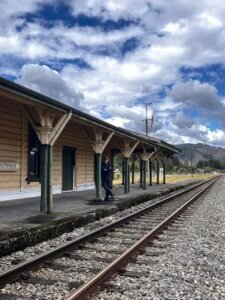
Siona and I wander over to the old station. Coal trains still use the line, but public services stopped in 1967. Could they restart, be part of Patsy’s plan? Build it, and they will come. Build it, and young people can be trained and get a career. Reefton Distilling Co., is as much a social project as a business.
I’ve seen the same situation on Scotland’s west coast. How the arrival of a distillery causes ripples across a community, bringing in jobs, and revitalising communities. This is more than a place making whisky and gin. It is a lifeline in a part of the world which has been stop-start for most of its life. Whisky gives a degree of permanence, it allows roots to be established.
If this works, it is here to stay, it is fixed. Whisky alone cannot save a town, but it can be an aid. This place, rocked in the tides of economics and the vagaries of geology has a future.
I think back to how Andrew kept talking about things needing time. He’s right. Whisky cannot be instant. It demands attention and understanding of where it is from, seeing what the conditions give. t is like the greenstone and gold miners, finding a way through, clearing a trail, finding out what is possible, showing the way.
Starting a new distillery is always a gamble, but these early days are when steady expansion is required, laying down sufficient stock in anticipation of what might happen in seven or eight years time. It needs a steady hand.
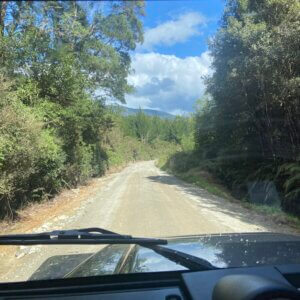
With directions scrawled on a card, we loop back to Arthur’s Pass, through back roads and dusty white gravel tracks, into the rainforest, thick with ancient ferns and vines. ‘Imagine if there was a lake here,’ says Siona, and one appears as if by magic – dark water at the foot of a green wall of trees. We hit the pass and the rainforest gives way to rolling tawny hills and then the lush Canterbury plains. Back to cattle and sheep country. The road will now turn south.